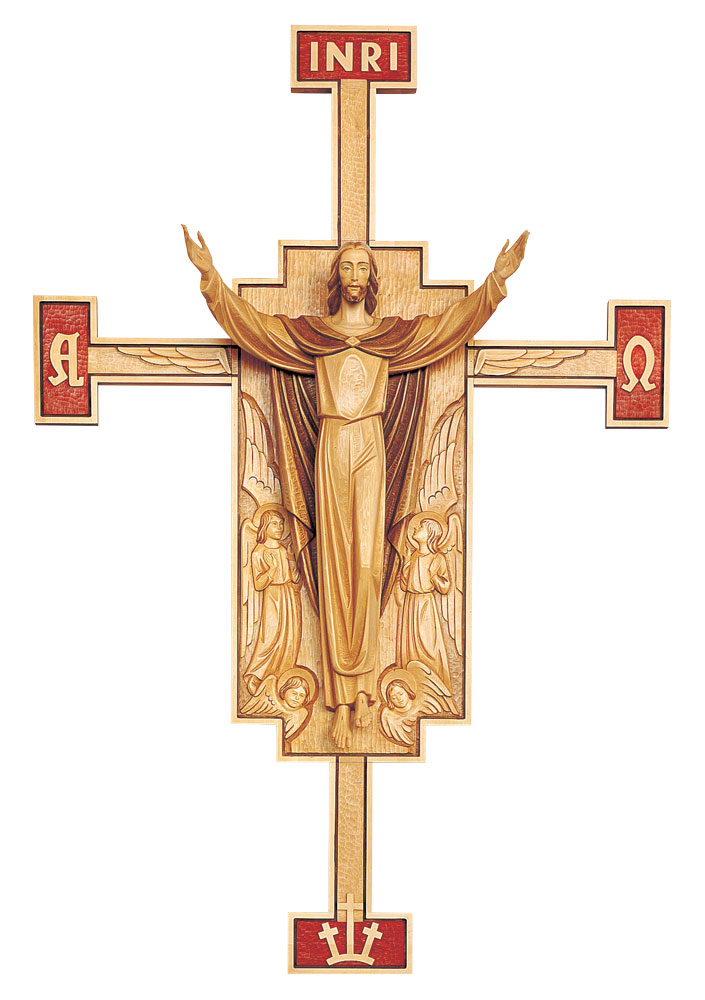You are using an out of date browser. It may not display this or other websites correctly.
You should upgrade or use an alternative browser.
You should upgrade or use an alternative browser.
Catholic Images (TAW Forum)
- Thread starter Not David
- Start date
- Nov 28, 2003
- 21,606
- 12,138
- 58
- Country
- Australia
- Faith
- Eastern Orthodox
- Marital Status
- Married
I always wondered where it was from.It's a short hop, from that to:
View attachment 260433
(PS.... I know it's actually from a comedy movie )
Upvote
0
- Apr 6, 2018
- 7,356
- 5,235
- 25
- Country
- United States
- Faith
- Eastern Orthodox
- Marital Status
- Single
Which icons of the Theotokos have similar garments?To the OP's question, we venerate images because of their connection to the prototype. Just because an image is Catholic, just because it is western style, or just because it is a statue doesn't mean it shouldn't be venerated. If it is unrecognizable as the person it is depicting or presents bad theology, we shouldn't venerate it. All of the images that you posted make me uncomfortable, but then I'm not wild about the Umilenie icon that Saint Seraphim prayed in front of for a thousand days. And there are icons of the Theotokos with garments similar to the statues you posted, so I would be hard pressed to condemn them. There are surely better images out there, but not necessarily that you have access to.
Upvote
0
- Apr 6, 2018
- 7,356
- 5,235
- 25
- Country
- United States
- Faith
- Eastern Orthodox
- Marital Status
- Single
Well, those are the typical Catholic images in the place where I grew up.To be honest, when I looked at the photos in the OP, my first thought was of children playing with dolls. They don't really strike me as statues at all
Upvote
0
- Jan 26, 2007
- 41,563
- 20,082
- 41
- Country
- United States
- Faith
- Eastern Orthodox
- Marital Status
- Married
A movie called "Dogma", outside the church, where George Carlin, played a Cardinal.
yep, because an image of Christ should not give us the heebie jeebies (which technically is true).
Upvote
0
- Sep 29, 2016
- 1,507
- 822
- Country
- United States
- Faith
- Non-Denom
- Marital Status
- Single
- Politics
- US-Republican
Well, for one, some of these images are connected to Marian apparitions whose character should bring about skepticism. The second picture comes from “Our Lady of Good Sucess” which comes along with several prophesies which clearly aren’t Orthodox in character.
For two, if something is fundamentally distracting to you while you pray, you probably shouldn’t use it in prayer.
And for what it’s worth, statues which are obsessively gorey, use gel to replicate tears, uses hair, and statues which are dressed up in real clothes always made my stomach churn for some reason.
For two, if something is fundamentally distracting to you while you pray, you probably shouldn’t use it in prayer.
And for what it’s worth, statues which are obsessively gorey, use gel to replicate tears, uses hair, and statues which are dressed up in real clothes always made my stomach churn for some reason.
Last edited:
Upvote
0
dzheremi
Coptic Orthodox non-Egyptian
- Aug 27, 2014
- 13,567
- 13,728
- Country
- United States
- Faith
- Oriental Orthodox
- Marital Status
- Private
I've always heard, from both your Church and mine, that icons are our "windows to heaven", i.e., that they give us glimpses into what and who awaits us after the resurrection and judgment, should we make it there (Lord have mercy).
Granted, that's not their only purpose (some, like the milk-giver icons, emphasize the humanity of Christ for theological reasons, rather than depicting what we should expect to see in heaven), but if we take that as a base from which to understand the function of icons in the context of Orthodox theology, then it should make sense why certain Catholic images "give us the heebie jeebies", to quote Fr. Matt above. While I agree with the OP that it is good that we not rely on our feelings, it can also be a good sign when we are disquieted by things that give us pause for theological reasons, even if we can't always put our finger on why. I mean, I'm no iconographer, but I can definitely see the difference between this:

And this:

(Sorry for the wonky bit of the image in the bottom left where I had to try my best in MS Paint to cover the artist's full name and phone number which some yahoo put on the photo in an attempt to watermark it/drum up further business...ugh.)
These both depict the same event (St. Bishoy, 320-417, carrying Christ in the desert), which is a well-known event in the saint's life, but obviously the latter is more Western-influenced and fleshy. I am not personally a fan of the Scandinavian Jesus look of the second, though to be honest the first is not my personal favorite image of this event, either (it's just the icon that happened to be in my home church when I took that photo). But at least it meets the basics of Coptic iconography in ways that the other doesn't: in the 'matching' look and proportions of the faces, in the color palate that fits 'neo-Coptic' iconography, in actually identifying the saint by name and with a traditional honorific Pimenrit ente Iisous Pekhristos "The beloved of Jesus Christ", which echoes his commemoration in the liturgy, etc. So it can properly be considered an icon, and I can venerate it with no reservations (which we did, being a parish named after the saint in question). The second image should probably not be venerated at all, and I only say 'probably' because the Church unfortunately cannot dictate to people that they cannot have chintzy-looking RC-influenced wall art that looks like it belongs in my grandma's house in their own houses. I mean, I guess it could, but I mean that in the same way that you'd still live in a country that is inundated with RC images, produced by people that don't know better and sold to people that don't know better, regardless of any decree. It's a problem of not enough people knowing the difference, because they are poorly theologically-informed with regard to icons. This is precisely why the theological principles behind iconography are so important and need to be taught everywhere, and on this front I would certainly hope that more OO would begin to look to the EO for an example of how to do that. (Since we never had a problem with iconoclasm as a communion, we likewise never had to defend icons, and since the 19th century more and more Western art has crept into OO countries like Egypt and Ethiopia, where it coexists rather uneasily and poorly with the traditional iconography that you would have found absolutely everywhere as recently as the 18th century, e.g., in the art of an iconographer like Yuhanna al-Armani, whose works decorate the 3rd century "Hanging Church" of Old Cairo.)
The point here is not to write a treatise on Coptic or OO iconography in particular, but to say that when you recognize what is proper and acceptable in your tradition -- and its deep reasons for being so (that it is an integral part of the expression of the theology that is likewise expressed in the liturgy and in all aspects of the Church's life) -- then things outside of it may be recognized as being such, and your reaction to them is probably going to change. So this is a good step, despite how uncomfortable I'm sure it feels. As to what you should do about it...well, the EO posters have said as much. I am with them that printing out icons that you see online and framing them seems to be the best solution for now. This is something that people I know have done, but I have not done so because I do not have access to a color printer.
Granted, that's not their only purpose (some, like the milk-giver icons, emphasize the humanity of Christ for theological reasons, rather than depicting what we should expect to see in heaven), but if we take that as a base from which to understand the function of icons in the context of Orthodox theology, then it should make sense why certain Catholic images "give us the heebie jeebies", to quote Fr. Matt above. While I agree with the OP that it is good that we not rely on our feelings, it can also be a good sign when we are disquieted by things that give us pause for theological reasons, even if we can't always put our finger on why. I mean, I'm no iconographer, but I can definitely see the difference between this:
And this:
(Sorry for the wonky bit of the image in the bottom left where I had to try my best in MS Paint to cover the artist's full name and phone number which some yahoo put on the photo in an attempt to watermark it/drum up further business...ugh.)
These both depict the same event (St. Bishoy, 320-417, carrying Christ in the desert), which is a well-known event in the saint's life, but obviously the latter is more Western-influenced and fleshy. I am not personally a fan of the Scandinavian Jesus look of the second, though to be honest the first is not my personal favorite image of this event, either (it's just the icon that happened to be in my home church when I took that photo). But at least it meets the basics of Coptic iconography in ways that the other doesn't: in the 'matching' look and proportions of the faces, in the color palate that fits 'neo-Coptic' iconography, in actually identifying the saint by name and with a traditional honorific Pimenrit ente Iisous Pekhristos "The beloved of Jesus Christ", which echoes his commemoration in the liturgy, etc. So it can properly be considered an icon, and I can venerate it with no reservations (which we did, being a parish named after the saint in question). The second image should probably not be venerated at all, and I only say 'probably' because the Church unfortunately cannot dictate to people that they cannot have chintzy-looking RC-influenced wall art that looks like it belongs in my grandma's house in their own houses. I mean, I guess it could, but I mean that in the same way that you'd still live in a country that is inundated with RC images, produced by people that don't know better and sold to people that don't know better, regardless of any decree. It's a problem of not enough people knowing the difference, because they are poorly theologically-informed with regard to icons. This is precisely why the theological principles behind iconography are so important and need to be taught everywhere, and on this front I would certainly hope that more OO would begin to look to the EO for an example of how to do that. (Since we never had a problem with iconoclasm as a communion, we likewise never had to defend icons, and since the 19th century more and more Western art has crept into OO countries like Egypt and Ethiopia, where it coexists rather uneasily and poorly with the traditional iconography that you would have found absolutely everywhere as recently as the 18th century, e.g., in the art of an iconographer like Yuhanna al-Armani, whose works decorate the 3rd century "Hanging Church" of Old Cairo.)
The point here is not to write a treatise on Coptic or OO iconography in particular, but to say that when you recognize what is proper and acceptable in your tradition -- and its deep reasons for being so (that it is an integral part of the expression of the theology that is likewise expressed in the liturgy and in all aspects of the Church's life) -- then things outside of it may be recognized as being such, and your reaction to them is probably going to change. So this is a good step, despite how uncomfortable I'm sure it feels. As to what you should do about it...well, the EO posters have said as much. I am with them that printing out icons that you see online and framing them seems to be the best solution for now. This is something that people I know have done, but I have not done so because I do not have access to a color printer.
Upvote
0
nutroll
Veteran
- Apr 26, 2006
- 2,221
- 1,301
- 47
- Country
- United States
- Faith
- Eastern Orthodox
- Marital Status
- Married
I was thinking in particular of the Theotokos of the Unfading Rose:Which icons of the Theotokos have similar garments?
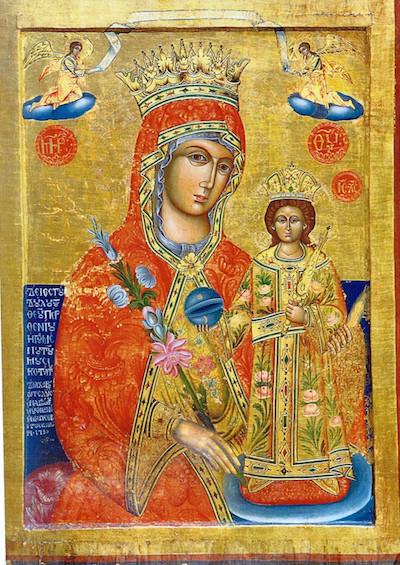
Not an exact match, but also not what most of us think of when we think of icons of Christ and the Theotokos.
Upvote
0
~Anastasia~
† Handmaid of God †
- Dec 1, 2013
- 31,133
- 17,455
- Country
- United States
- Faith
- Eastern Orthodox
- Marital Status
- Married
I've always heard, from both your Church and mine, that icons are our "windows to heaven"<snip>
if we take that as a base from which to understand the function of icons in the context of Orthodox theology, then it should make sense why certain Catholic images "give us the heebie jeebies", to quote Fr. Matt above. While I agree with the OP that it is good that we not rely on our feelings, it can also be a good sign when we are disquieted by things that give us pause for theological reasons, even if we can't always put our finger on why. I mean, I'm no iconographer, but I can definitely see the difference between this:
View attachment 260441
And this:
View attachment 260442
These both depict the same event (St. Bishoy, 320-417, carrying Christ in the desert), which is a well-known event in the saint's life, but obviously the latter is more Western-influenced and fleshy. I am not personally a fan of the Scandinavian Jesus look of the second, though to be honest the first is not my personal favorite image of this event, either (it's just the icon that happened to be in my home church when I took that photo). But at least it meets the basics of Coptic iconography in ways that the other doesn't: in the 'matching' look and proportions of the faces, in the color palate that fits 'neo-Coptic' iconography, in actually identifying the saint by name and with a traditional honorific Pimenrit ente Iisous Pekhristos "The beloved of Jesus Christ", which echoes his commemoration in the liturgy, etc.
Yes, yes, and yes - as far as comparing proper icons and artistic renditions. I couldn't explain it, and I suppose it came about kind of naturally through practice, but the FEELING is so different, and the theology is right on the surface of that.
Thank you for saying better than I could.
Upvote
0
This site stays free and accessible to all because of donations from people like you.
Consider making a one-time or monthly donation. We appreciate your support!
- Dan Doughty and Team Christian Forums
- Apr 6, 2018
- 7,356
- 5,235
- 25
- Country
- United States
- Faith
- Eastern Orthodox
- Marital Status
- Single
I read the director stopped being Catholic because he got to the conclusion that his dead dog had no religion.A movie called "Dogma", outside the church, where George Carlin, played a Cardinal.
Upvote
0
- Apr 6, 2018
- 7,356
- 5,235
- 25
- Country
- United States
- Faith
- Eastern Orthodox
- Marital Status
- Single
I read in another forum that the Theotokos with crown is a Roman Catholic influence in Russia.I was thinking in particular of the Theotokos of the Unfading Rose:
Not an exact match, but also not what most of us think of when we think of icons of Christ and the Theotokos.
Upvote
0
- Apr 6, 2018
- 7,356
- 5,235
- 25
- Country
- United States
- Faith
- Eastern Orthodox
- Marital Status
- Single
Also, talking about morbid is this image:

Upvote
0
dzheremi
Coptic Orthodox non-Egyptian
- Aug 27, 2014
- 13,567
- 13,728
- Country
- United States
- Faith
- Oriental Orthodox
- Marital Status
- Private
Yes, yes, and yes - as far as comparing proper icons and artistic renditions. I couldn't explain it, and I suppose it came about kind of naturally through practice, but the FEELING is so different, and the theology is right on the surface of that.
Thank you for saying better than I could.
Yes, the point is not that every person becomes the arbiter of what is correct (that's why it's not "following your feelings", even though you do feel "Hmmm...something is off here", or alternatively, "Yes, this is correct"), but that after enough exposure you get to see the repeating themes and methods of conveying them as proper means of expressing the theology itself, just as is also done in prayer, in fasting, etc. (in everything that is done). It is part of realizing the theological significance of everything you do as a Church, which is often something that the Orthodox say that the modern RC has lost.
I remember when I was leaving the RCC, a well-meaning Catholic acquaintance said to me "I don't know why you think you need to leave; you can be Eastern Catholic if you like _____" (the Arabic language, 'Eastern' icons, Egyptian food...I don't remember at this point...just 'stuff'). At the time I could not explain it, but I knew that this was not the answer. I can't remember if this was before or after my visit to the Ruthenian Catholics which did nothing but strengthen me in my resolve to get out (that's not a slander against those people; that's just what happened), but somehow I knew it wasn't a matter of personal likes or dislikes. There are some completely Roman Catholic icons that are specifically (re)made in imitation of Eastern Orthodox/Byzantine icons, like the Black Madonna of Czestochowa. We actually had a reproduction of that in my old Latin parish in Oregon, which I tried for some time to venerate (couldn't really do it; didn't know why). If art historians are correct that the base of the painting was a Byzantine icon created in the 6th-9th century, then presumably there would be no obstacle to EO people venerating it if everything were about form (though there have been some changes made to it to make it more "Western", as detailed at the link), but it's clear that this is not the case, given its long historical association (at least since the 14th century) with the Roman Catholic Church in Poland. Since it is Roman Catholic, it represents RC theology which is not acceptable to the EO.
So it's curious to me how much a discussion of this topic really reveals a different mindset, at least on the part of the Latin Catholics who make up the vast majority of the Roman communion and produce the images and statues seen in the OP. I mean, compare what is taken to be RC iconography now with what was being produced in Catalunya, Spain as recently as the 12th century (after the conventional dating of the East-West schism):
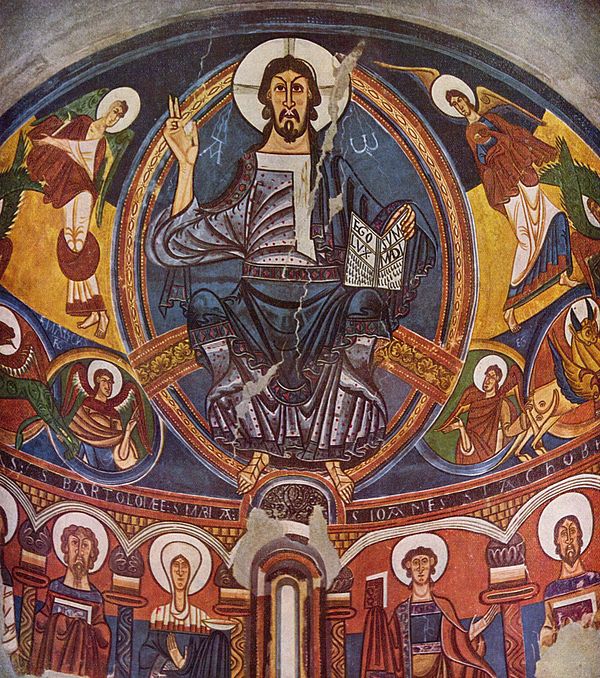
Pictured: The famous Apse of Sant Climent
If you told me that was a Byzantine fresco from whatever century back then, I would have a hard time objecting. I mean, you would probably have reasons for pointing out why it isn't (e.g., the writing is all in Latin, which Justinian I was the last ruler in the East to be a native speaker of, many centuries before this was painted), but I'd believe you if you said it was and I wasn't wearing my glasses that day.
At any rate, it is very far from the kinds of images shown by the OP in the thread.
Upvote
0
DraculKain
Orthodox Christian
- Jun 21, 2019
- 35
- 39
- Country
- United States
- Faith
- Eastern Orthodox
- Marital Status
- Married
yep, because an image of Christ should not give us the heebie jeebies (which technically is true).
George Carlin was speaking Orthodox language for at least a few minutes of his life. If he’s in the Kingdom after the final judgment and I am as well I just might spend eternity in holy and celebratory laughter.
Upvote
0
This site stays free and accessible to all because of donations from people like you.
Consider making a one-time or monthly donation. We appreciate your support!
- Dan Doughty and Team Christian Forums
- Aug 24, 2012
- 20,735
- 13,171
- Country
- United States
- Faith
- Pentecostal
- Marital Status
- Private
- Politics
- US-Constitution
Upvote
0
- Sep 29, 2016
- 1,507
- 822
- Country
- United States
- Faith
- Non-Denom
- Marital Status
- Single
- Politics
- US-Republican
Also, talking about morbid is this image:
Oh boy, you could do far worse.
I had something like this in mind (WARNING: REALLY GOREY, DO NOT SEE IF YOU ARE SENSITIVE TO BLOOD AND WOUNDS; IT IS A STATUE OF CHRIST COMPLETELY COVERED FROM HEAD TO TOE WITH WOUNDS AND GASHES):
https://live.staticflickr.com/2833/33220649853_309d173140_b.jpg
While I haven't had the misfortune of actually experiencing a statue like this inside a Catholic Church, I know that such statues can be commonplace in some specific Churches.
And I understand the Western piety of trying to show how bad Christ's Crucifixion was, and motivate us to resist temptations which are far smaller in magnitude - but .... ugh; I can't imagine praying using this; my younger self would also feel the same.
Upvote
0
- Nov 28, 2003
- 21,606
- 12,138
- 58
- Country
- Australia
- Faith
- Eastern Orthodox
- Marital Status
- Married
Surely that is in an art gallery? I can't imagine anything like that in a Church!Oh boy, you could do far worse.
I had something like this in mind (WARNING: REALLY GOREY, DO NOT SEE IF YOU ARE SENSITIVE TO BLOOD AND WOUNDS; IT IS A STATUE OF CHRIST COMPLETELY COVERED FROM HEAD TO TOE WITH WOUNDS AND GASHES):
https://live.staticflickr.com/2833/33220649853_309d173140_b.jpg
While I haven't had the misfortune of actually experiencing a statue like this inside a Catholic Church, I know that such statues can be commonplace in some specific Churches.
And I understand the Western piety of trying to show how bad Christ's Crucifixion was, and motivate us to resist temptations which are far smaller in magnitude - but .... ugh; I can't imagine praying using this; my younger self would also feel the same.
Search image on Google:
Jesus is Scourged. Chapel of Mount Aloysius College in Cresson, PA.
Upvote
0
This site stays free and accessible to all because of donations from people like you.
Consider making a one-time or monthly donation. We appreciate your support!
- Dan Doughty and Team Christian Forums
- Sep 29, 2016
- 1,507
- 822
- Country
- United States
- Faith
- Non-Denom
- Marital Status
- Single
- Politics
- US-Republican
Yes, the point is not that every person becomes the arbiter of what is correct (that's why it's not "following your feelings", even though you do feel "Hmmm...something is off here", or alternatively, "Yes, this is correct"), but that after enough exposure you get to see the repeating themes and methods of conveying them as proper means of expressing the theology itself, just as is also done in prayer, in fasting, etc. (in everything that is done). It is part of realizing the theological significance of everything you do as a Church, which is often something that the Orthodox say that the modern RC has lost.
I remember when I was leaving the RCC, a well-meaning Catholic acquaintance said to me "I don't know why you think you need to leave; you can be Eastern Catholic if you like _____" (the Arabic language, 'Eastern' icons, Egyptian food...I don't remember at this point...just 'stuff'). At the time I could not explain it, but I knew that this was not the answer. I can't remember if this was before or after my visit to the Ruthenian Catholics which did nothing but strengthen me in my resolve to get out (that's not a slander against those people; that's just what happened), but somehow I knew it wasn't a matter of personal likes or dislikes. There are some completely Roman Catholic icons that are specifically (re)made in imitation of Eastern Orthodox/Byzantine icons, like the Black Madonna of Czestochowa. We actually had a reproduction of that in my old Latin parish in Oregon, which I tried for some time to venerate (couldn't really do it; didn't know why). If art historians are correct that the base of the painting was a Byzantine icon created in the 6th-9th century, then presumably there would be no obstacle to EO people venerating it if everything were about form (though there have been some changes made to it to make it more "Western", as detailed at the link), but it's clear that this is not the case, given its long historical association (at least since the 14th century) with the Roman Catholic Church in Poland. Since it is Roman Catholic, it represents RC theology which is not acceptable to the EO.
So it's curious to me how much a discussion of this topic really reveals a different mindset, at least on the part of the Latin Catholics who make up the vast majority of the Roman communion and produce the images and statues seen in the OP. I mean, compare what is taken to be RC iconography now with what was being produced in Catalunya, Spain as recently as the 12th century (after the conventional dating of the East-West schism):

Pictured: The famous Apse of Sant Climent
If you told me that was a Byzantine fresco from whatever century back then, I would have a hard time objecting. I mean, you would probably have reasons for pointing out why it isn't (e.g., the writing is all in Latin, which Justinian I was the last ruler in the East to be a native speaker of, many centuries before this was painted), but I'd believe you if you said it was and I wasn't wearing my glasses that day.
At any rate, it is very far from the kinds of images shown by the OP in the thread.
If you go to areas of the West which had greater Byzantine influence, such as Italy, it's kind of shocking how similar some forms of Western Art was back then to Byzantine Iconography today.
Go to Santa Maria Maggiore (Saint Mary Major) in Rome.
It contains mosaics from the 5th century:
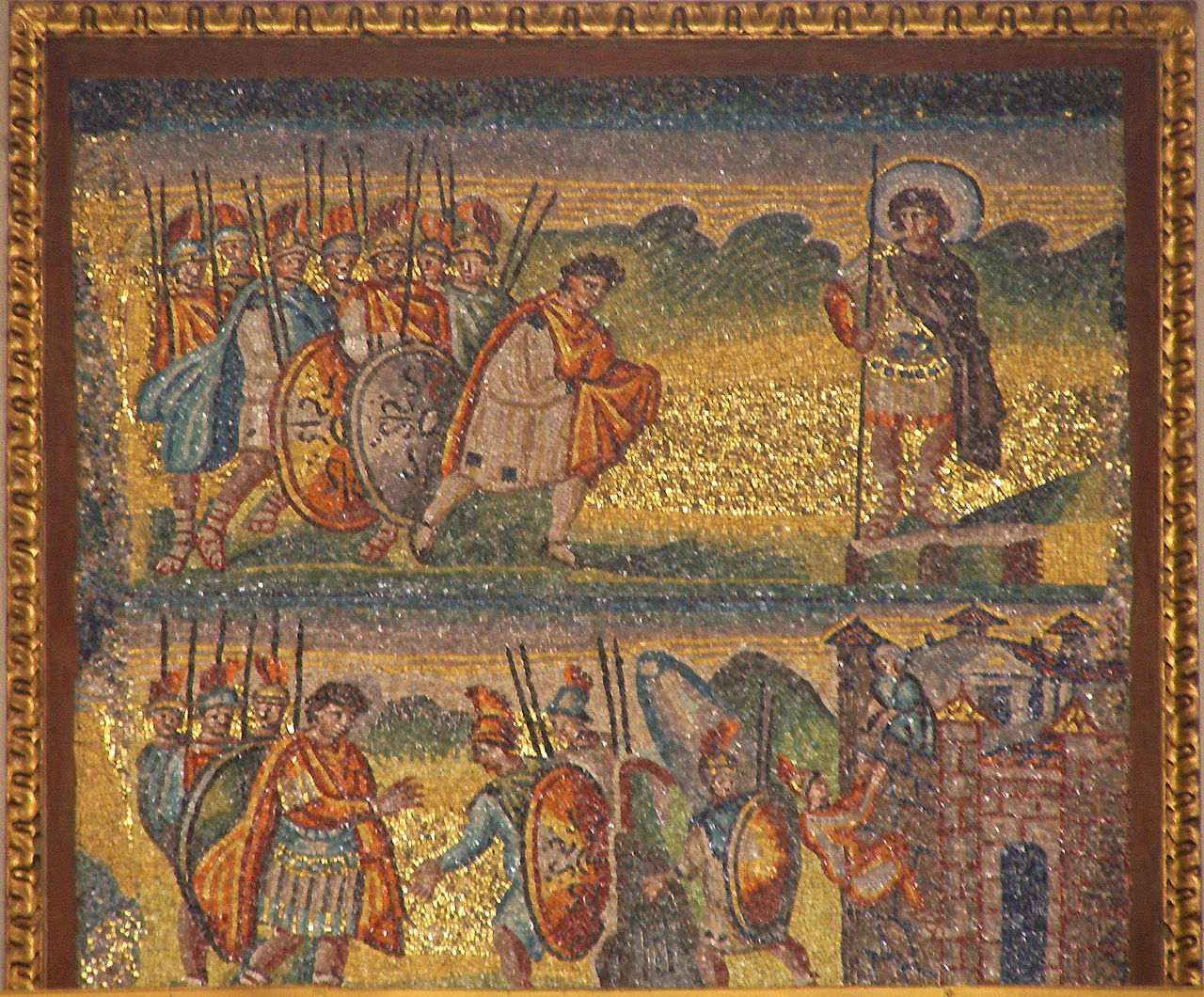
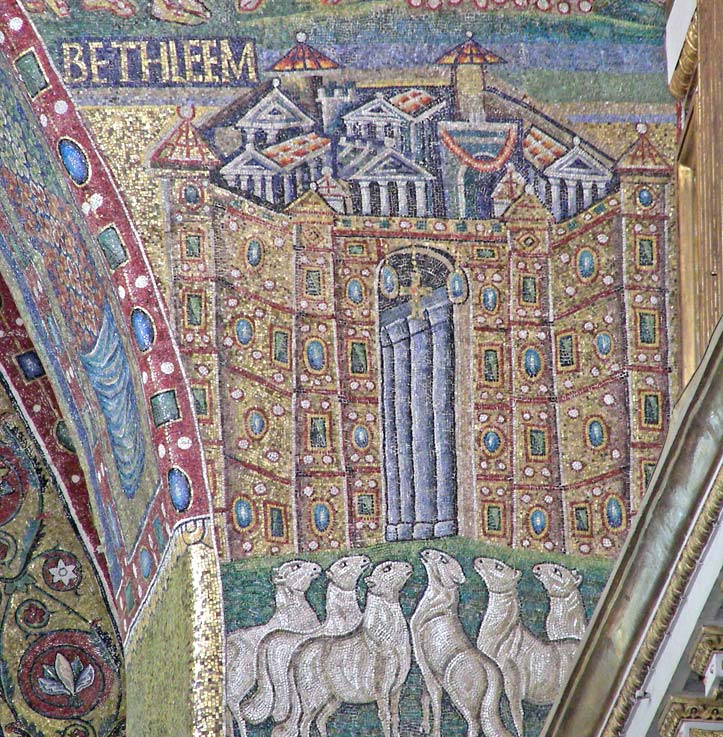
This icon of the Virgin Mary from the 6th century, given to Pope Saint Gregory the Great as a gift from Byzantium (Salus Populi Romani - or "Salvation of the Roman People")
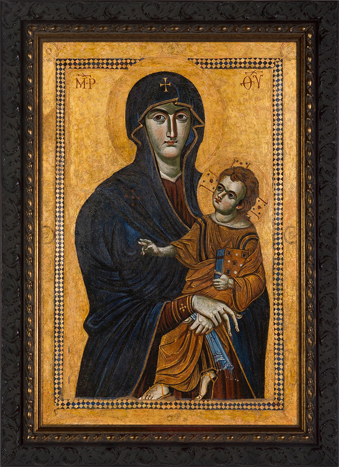
And this mosaic from the 13th century, as well as others from the 13th century:
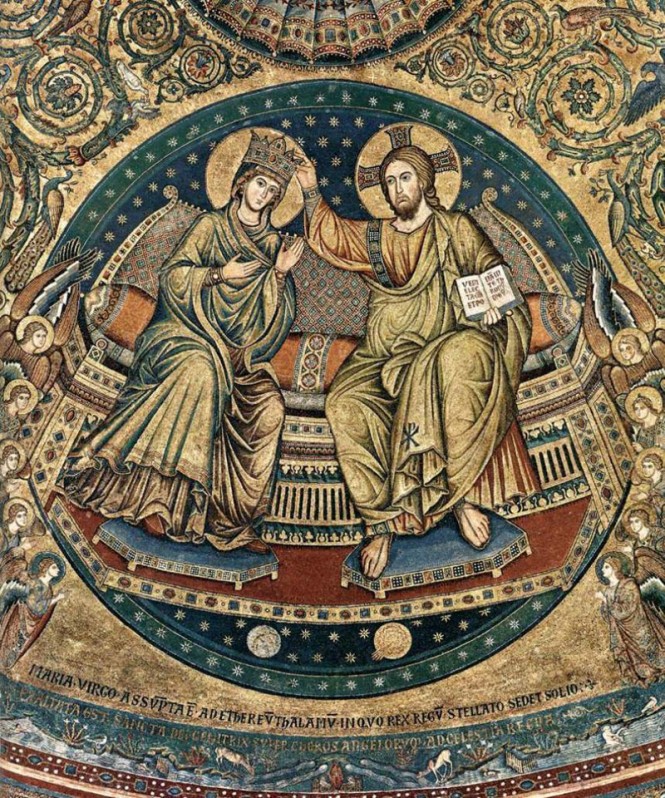
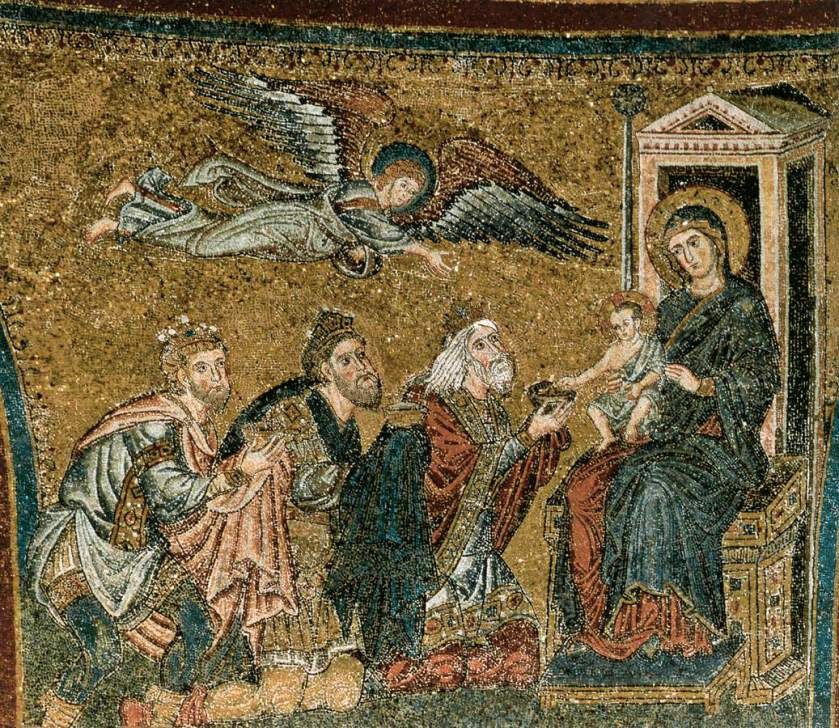
Again, I don't want to make the case that ALL OF THE WEST had art like this - it's clear that Spain's art, for example, was far more like what you posted than this, and Celtic iconography in the 1st millenium was far more unique and indigenous; but it only further solidifies the point that Rome once had iconography like the Orthodox Church does - even post-schism.
Upvote
0
Similar threads
- Replies
- 0
- Views
- 95
- Replies
- 2
- Views
- 175
- Replies
- 0
- Views
- 56
- Replies
- 1
- Views
- 81

